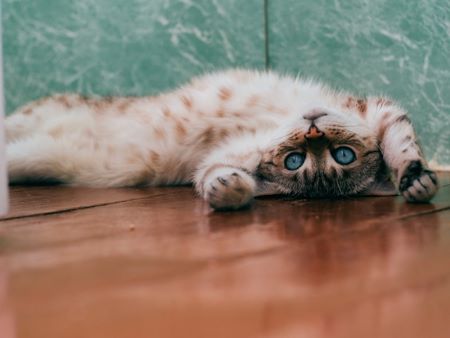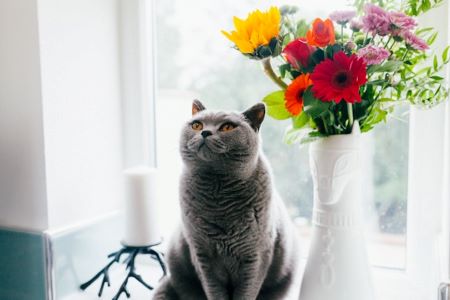Cats & Essential Oils, An Expert Opinion
I have been practicing aromatherapy for animals since 1997. Over the years I have used essential oils, hydrosols and herbal oils with cats with health or behaviour problems, with great success and no harmful side-effects. If you follow a few basic guidelines, essential oils and hydrosols can be a safe and effective solution for many common feline problems.

Felis Catus is one of the most successful species on the planet! If just one whiff of essential oil was going to cause kitty to keel over he would not have made it to where he is today. In a natural environment cats are exposed to essential oils daily, they are everywhere that plants grow. As they walk through the undergrowth, rubbing against flowers, twigs, leaves essential oils are released, albeit in minute amounts. When your cat rolls in a bed of catnip, he releases essential oil from the plant. So obviously they have some tolerance. It is OVERUSE of essential oils that can be dangerous.
If we use nature’s guidance and allow cats the choice to interact with aromatics when and how they like, they will cause no harm, quite the contrary, your cat can only benefit. Allowing self-selection is an easy and non-invasive way to provide your cats with the natural healing substances that would be available to them in nature. This is especially important for indoor cats.
Essential Oils Used Wrongly Can Kill Cats
I am not saying that there is no risk to using aromatics with cats. They are definitely more vulnerable to the misuse of essential oils than some animals. Cats lack an important detoxification mechanism, known as glucuronidation, which is present in most mammals. This limits their ability to process some of the monoterpenes present in essential oils, which can easily build up in the liver.

There are cases of liver failure in cats after exposure to essential oils, but this has always been when a cat was forced to interact with the essential oil. A well known case tells of someone who shaved her cats and applied undiluted tea tree oil to their skin to kill fleas. An obvious case of over use. But I have also been involved with cats who suffered liver congestion, digestive upset, lethargy and symptoms of neurological disease after being exposed to daily diffusion of essential oils in the home.
So yes, to avoid possible fatal toxic shock (at worst) or a build up of toxic metabolites in the body, you must be very cautious when using essential oil with cats. Especially avoid the more pungent, camphoraceous oils, such as eucalyptus, pine, or tea tree, or anything high in phenols.
Every medicine can be toxic if misused. The safe way to use aromatics with cats is to dilute highly and allow your cats to choose how, when, and with what to interact. When you do this you will find that inhalation is the preferred method of interaction. And a tiny amount is enough to trigger healing.
I recommend using hydrosols with cats. This is the water part of the distillation that produces essential oil. Hydrosols contain the more gentle water-soluble molecules of the plant, and trace amounts of essential oil. They are safer to use than essential oils, and cats select them over an essential oil 90% of the time. However, little research has been done at this time about the physiological effects of hydrosols on cats so the same principles must be applied as when using essential oils: high dilutions and free choice.
Hydrosols For Cats
To use hydrosols for cats, let them select which one they like by smelling the bottle. Then add 3-10 drops in a saucer of water. Put it down away from the cat’s usual eating place so you can observe when they go there to interact. Allow her to self-medicate by either licking, inhaling or sleeping close to the bowl. The saucer should be changed daily and fresh drinking water must also be available.
How To Use Essential Oil/Hydrosol With Cats
If you follow these basic guidelines you can confidently provide the natural secondary metabolites your cat needs for well-being, without causing harm.
- Always allow your cat to choose whether he/she wants an essential oil/hydrosol. Always allow them to leave the area if they choose.
- Essential oils must always be used in very high dilutions (1 drop in 25 ml of carrier oil). Hydrosols can be up to a 20% dilution, as little as 1 drop in 100 ml can also be effective
- Never put essential oils on a cat’s body
- Do not close a cat in a room with essential oils diffusing
- Avoid harsh, camphoraceous or highly pungent essential oils. Gentle oils, such as Roman chamomile (Anthemis nobilis) are better tolerated
To find out if your cat wants or needs a certain essential oil or hydrosol, hold the closed bottle in your hand at least 6 inches away from your cat’s nose. Be patient and allow the cat to come towards the bottle if he/she wants, rather than you going towards the cat. Once you are sure the cat likes the oil (see responses below), dilute one drop in 25 ml (approx. 2 tablespoon) of cold-pressed sunflower oil.
- Signs of interest: Sniffs the bottle, a small sniff but returns to the bottle, tongue licks quickly, stays in room – Offer diluted oil once a day until the cat shows no more interest
- No interest: turns away from the aroma, leaves the room – Do not apply.
Cats are very sensitive to the oils so just a few sniffs is all that is needed to trigger the healing process. Cats are also quite subtle in their response to the oils, and sometimes secretive. If the cat stays in the room with you when the bottle is open count it as a positive response, even if they are acting nonchalant and indifferent.

If your cat has a wound or some other problem that might call for topical application, use hydrosols, herbs, or clays. Do not apply essential oils topically.
The Catnip Effect & The Energy Healers
Cats can become overwhelmed by the smell of essential oils, sniffing, licking or attacking their owner manically if the person smells of oils. This can lead people to believe that their cat really loves essential oil, when, in fact, it is over-stimulating their nervous system, literally driving them crazy. Cats can also behave as they do with catnip (after all, it is the essential oil in catnip that makes them crazy) jumping around and having a mad moment or five. It can be amusing for us, but too much over-stimulation is not healthy.
On the other hand, cats often like to ‘hang out’ near closed bottles of essential oil. I have a client who, mindful of the cautions, put her selection of oils inside a bag on top of a wardrobe out of harm’s way…. only to find that her cats had taken to sleeping beside it. Cats are energetically finely tuned and a collection of essential oils is giving off a powerful radiation to which they are naturally attracted, especially if they (or you) need some healing. There is no need to worry.
Listen To The One That Knows Best!
There is so much misinformation on the internet, I feel sorry for anybody trying to figure out what is safe for their beloved pets. , There is no definitive research on exactly how much essential oil a cat can tolerate (luckily, as horrible experiments would have to be done!), which means there is no trustworthy list of essential oils that are, or are not, safe. But there IS a safe way to administer aromatics, using your cats instinctive knowledge. If you use common sense, keep dosage to a minimum and allow your cats to guide you, there is no need to deprive them of this wonderful tool. I say this based on my 20 years of experience as a trained animal aromatherapist. And because you’d be a fool to think you know better than a cat!
Leave a comment if you have any thoughts or questions, we love to hear from you. If you would like to learn more about how essential oils can help your cats, (dogs, horses, any animal), try our courses. Or buy The Aromatic Cat book.
Main – Photo by Manja Vitolic on Unsplash



